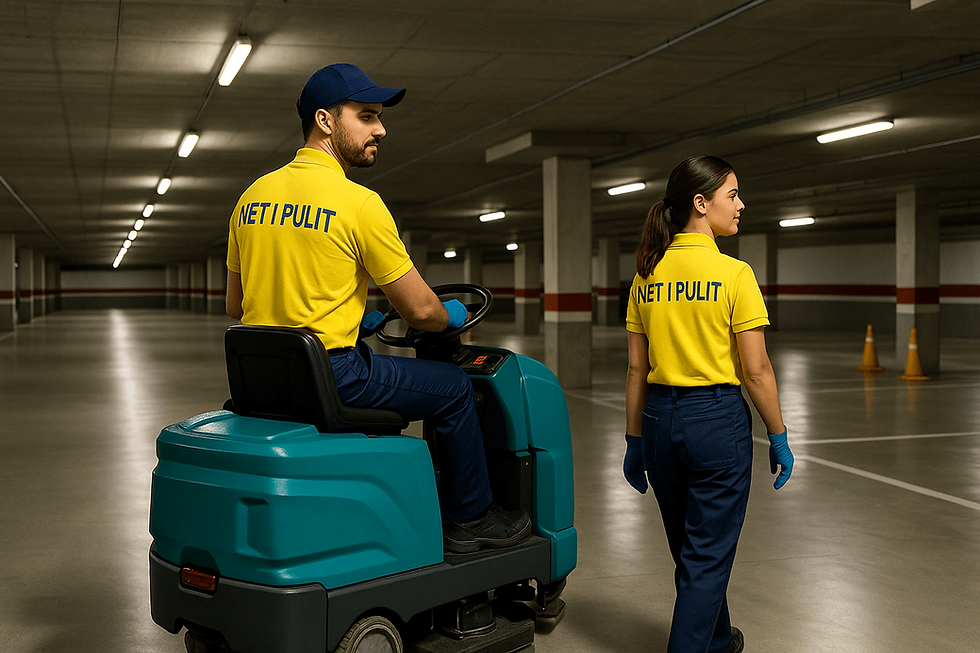Garage cleaning: how to remove dust and persistent odours
- Josep M Carulla Guia
- Oct 21
- 3 min read
Garages collect mineral dust, brake residue, rubber, oil stains and musty or fuel smells. To keep a car park clean, safe and odour-free, combine professional techniques (HEPA vacuuming, scrubber-dryers, pressure washing and true odour neutralisers) with a regular maintenance plan and proper ventilation. Here’s a clear, actionable guide you can apply today.

Why do dust and bad smells build up?
Constant vehicle traffic: brings in sand, dirt and metallic particles from brake pads.
Unsealed concrete: releases “cement dust” and re-suspends easily.
Spills and stains: oils and fuels penetrate pores and smell.
Damp and drains: dry or dirty traps cause sewer odours.
Insufficient ventilation: volatile compounds and smells concentrate at peak times.
24–48 h rapid action plan
High-level HEPA vacuuming: beams, cable trays, luminaires and pipes to avoid re-suspension.
Mechanical sweeping: remove grit and loose particles before wet cleaning.
Targeted degreasing of stains: alkaline/enzymatic degreaser, correct pad/brush, controlled rinse.
Scrubber-dryer cleaning: low-foam detergent; cross passes on ramps and entrances.
Pressure washing of critical points: corners, stained walls, lines, grates and channels.
Drains and traps: clean, disinfect and refill water traps; consider backflow valves.
Forced ventilation: renew air during and after the service; check extractor timers.
Odour neutralisation: controlled fogging with neutralisers (not perfumes) or ozone with strict safety protocol and no people present.
Preventive sealing (optional): epoxy or mineral consolidants to cut endogenous dust and ease future cleans.

Techniques & equipment that make the difference
Industrial HEPA vacuums for high areas and delicate surfaces.
Walk-behind/ride-on sweepers and scrubber-dryers for large surfaces.
Correct pads/brushes for epoxy, polished concrete or cement.
Pressure washers for ramps, walls and grates.
Fogging of neutralisers or ozone with PPE, signage and controlled timings.
Quality control: checklists, before/after photos and incident logs.
Products & treatments (without masking the smell)
Alkaline/enzymatic degreasers for oils and fuels.
Low-foam detergents for scrubber-dryers.
Odour neutralisers that capture/degrade molecules (better than fragrances).
Drain care: cleaning, refilling traps and preventive maintenance.
Sealers/coatings (epoxy or mineral) to mitigate dust from the slab itself.
Prevention & maintenance (practical calendar)
Daily/Weekly: light sweep on entrances/ramps; spot new stains.
Fortnightly/Monthly: full-floor scrubber-dryer; lifts, meter rooms and technical rooms.
Quarterly: pressure wash walls, pillars, grates and gullies; refresh floor markings if needed.
Semi-annual/Annual: deep treatment of stubborn stains, ventilation review and, if needed, re-coating or sealing.
Spill protocol: absorbents, signage and action within 15 minutes.
Ventilation: schedule purges at peak times and after deep cleans.

Safety basics
Signpost wet areas to avoid slips (adequate slip resistance).
Restrict vehicle and pedestrian access during works.
PPE for staff (goggles, gloves, respirator where applicable).
Active ventilation at all times; ozone only with empty space and safe re-entry.
Responsible handling of dirty water and waste per local rules.
How to know it’s working
Less visible dust on ledges and parked cars.
Fresh air when you open the bay: no mustiness, fuel or sewer smell.
Old stains shrinking or gone.
Fewer complaints and slip incidents.
Cleaning time per level improves over months.
Common mistakes to avoid
Masking with perfume instead of neutralising: the smell returns in hours.
Dry sweeping dusty floors: you throw dust into the air.
Ignoring grates and traps: nº1 source of sewer odour.
Fregging without pre-degreasing oil stains: they spread and set.
Ventilating only when it smells: ventilation must be preventive and scheduled.
When a professional service is worth it
Multi-storey car parks or high vehicle turnover.
Old, deep oil/fuel stains.
Persistent damp/sewer odours despite ventilation.
Night or weekend work required to avoid disruption.
Preparation before re-coating, inspections or letting/selling assets.
Typical cases we solve around Vallès and Barcelona
Cement dust in older unsealed garages in Sant Cugat del Vallès.
Fuel smell on enclosed ramps in Cerdanyola and Rubí.
Odour return from gullies in communities in Sabadell and Terrassa.
Stubborn stains on rented bays in Barcelona city.
Frequently asked questions (FAQs)
How often should a community garage be cleaned?
Standard communities: monthly scrubber-dryer and quarterly deep clean. Offices/retail with high turnover: fortnightly + quarterly.
How do you remove sewer odour?
Clean grates, refill traps, sanitise nearby areas and check backflow valves. If needed, treat ducts.
Can fuel smell be eliminated completely?
Usually yes: a mix of stain degreasing, correct ventilation and odour neutralisation.
Is ozone safe?
Yes, under protocol: empty space, controlled exposure time and ventilation before re-entry.
What about very old oil stains?
Deep degreasing + scrubber-dryer with the right pad, controlled repetitions and, if needed, micro-polish or local re-coat.
Do you work nights or weekends?
Yes, we adapt to minimise disruption.
Complementary services
Besides garages, we also clean high-reach glass, offices, industrial warehouses, communities and post-construction, plus specialised server room & data-centre cleaning and solar panel cleaning.
Want to remove dust and bad odours from your garage with results visible from day one? Request a quote with a free technical visit




Comments